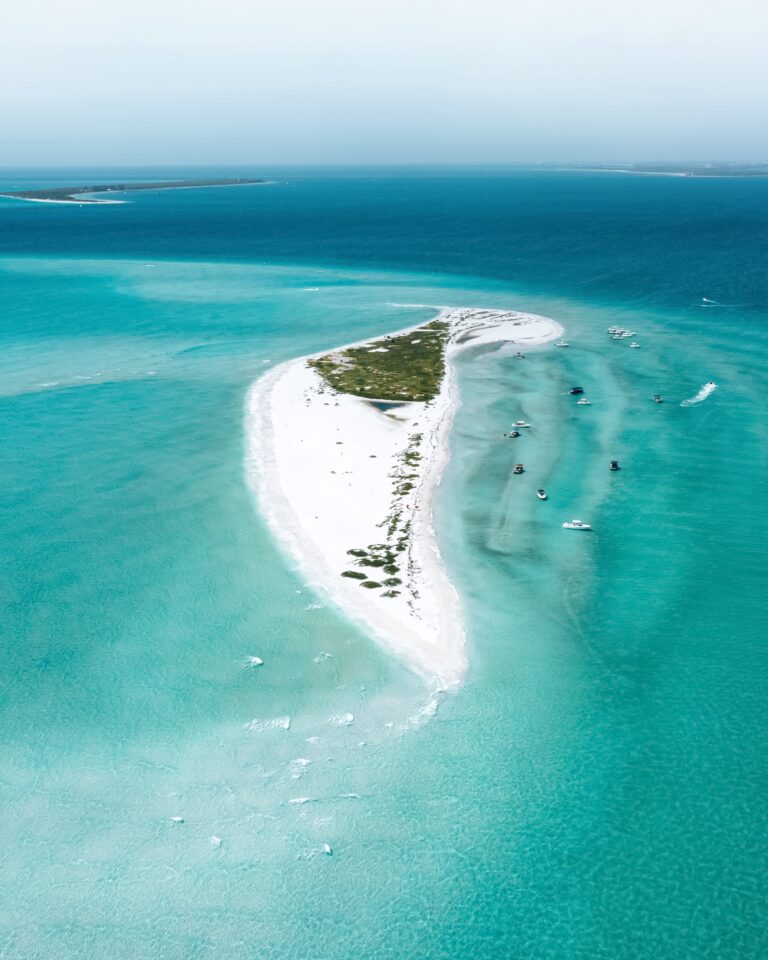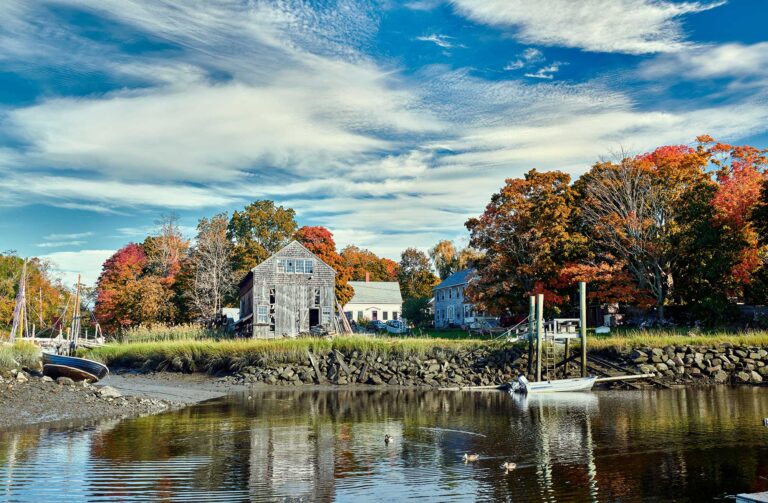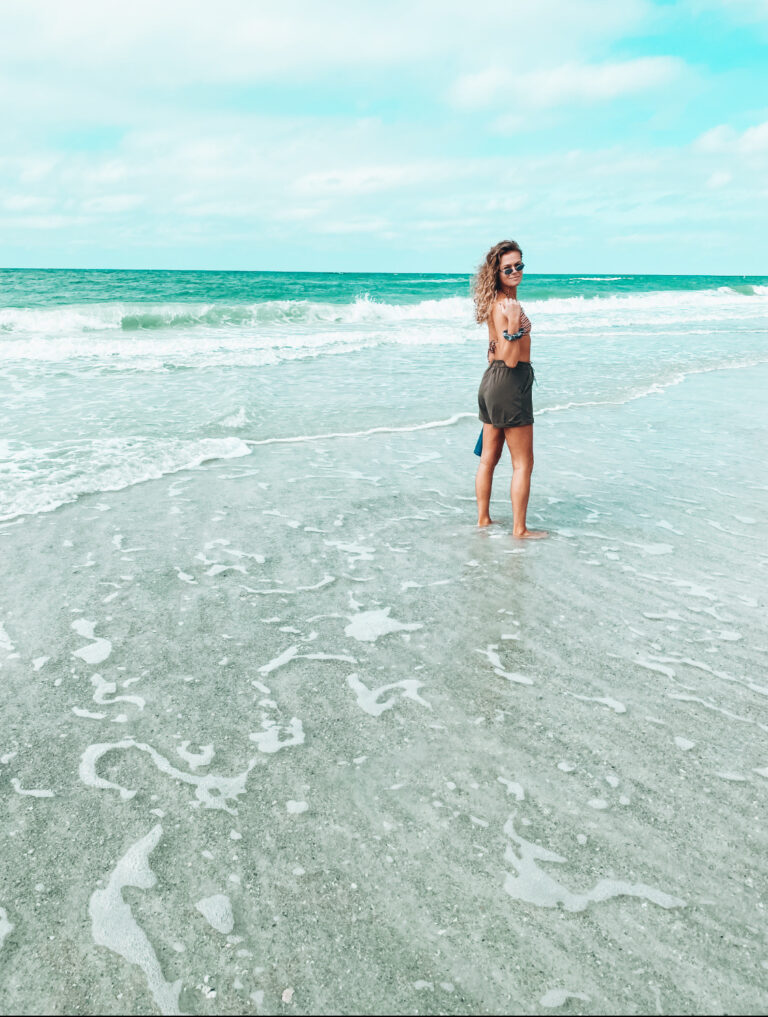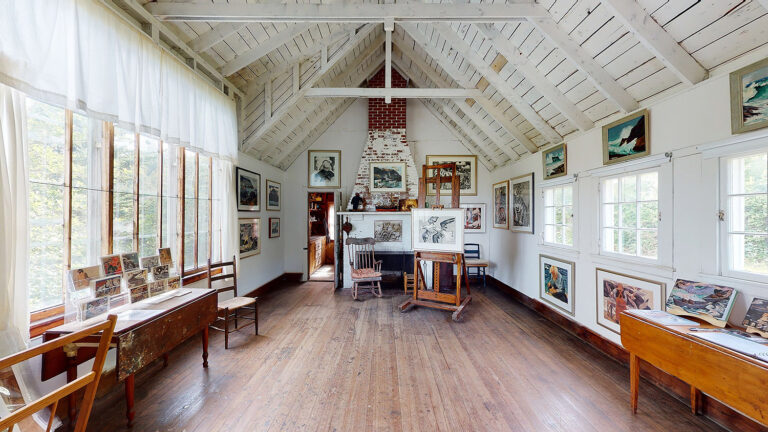11+ Hot Springs In Yellowstone You Won’t Want To Miss
Looking for the most incredible natural hot springs in Yellowstone? You’ll love every spot on this list!
Geothermally, Yellowstone National Park is one of the most active places globally. You can enjoy half of the world’s geothermal features here. Due to the park’s position in an active caldera, you can find almost 10,000 geysers, hot springs, mud pots, and fumaroles.
Yellowstone’s mega volcano has erupted with incredible intensity multiple times in the previous two million years. Lava flows and volcanic materials cover the vast majority of Yellowstone’s territory.
Yellowstone National Park quickly became recognized for its hot springs and a wide range of fauna. Since its establishment, visitors worldwide have flocked to Yellowstone National Park, eager to be both spectators and participants in the hot springs that define the Yellowstone region.
If you visit Yellowstone early in the morning when the air is crisp and chilly, you can see plumes of steam rising into the sky wherever you turn from boiling rivers, streams, and hot springs.
You can only see some of the hot springs in Yellowstone by hiking, while others by stopping by the roadside. But regardless, there’s more than enough spots to check out!
Here are some of the most spectacular hot springs in Yellowstone National Park that you simply can’t miss.
11. Beryl Spring
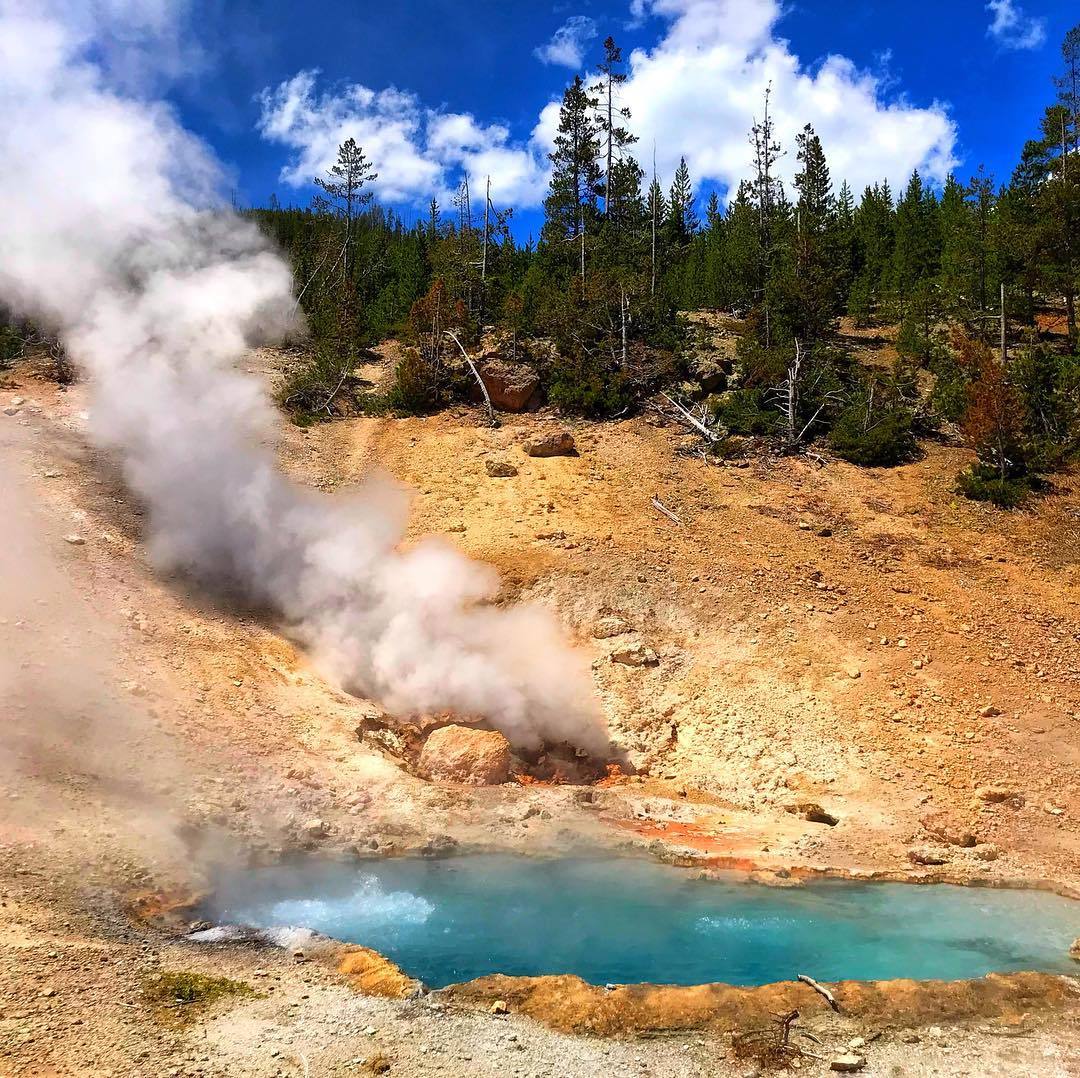
Beryl Spring, pronounced “burl,” is a well-known tourist destination and a little spring located off the highway leading to or from Norris Geyser Basin or just beside the road heading south toward Gibbons Falls. Water in this thermal feature reaches a temperature much over the boiling point.
It glows a brilliant blue-green in the sunlight, and at temperatures just below boiling, it is one of Yellowstone’s hottest hot springs.
Visitors can get close to the hot spring by walking on the pavement. As you drive by on a chilly morning, there will likely be a big white cloud of steam floating over the road from the enormous heat of Beryl Spring.
When visited at lower temps, such as early morning, this Yellowstone hot spring produces tremendous plumes of steam that obscure this section of roadway. Visit a little later in the day when the sun is out to see the spring hues.
The sulfur stench was robust, with clouds of steam and fumes pouring over the boardwalk. The mist made a loud noise as it exited the hole, which was fascinating. It’s just a slight detour, but it’s well worth it!
10. Mammoth Hot Springs
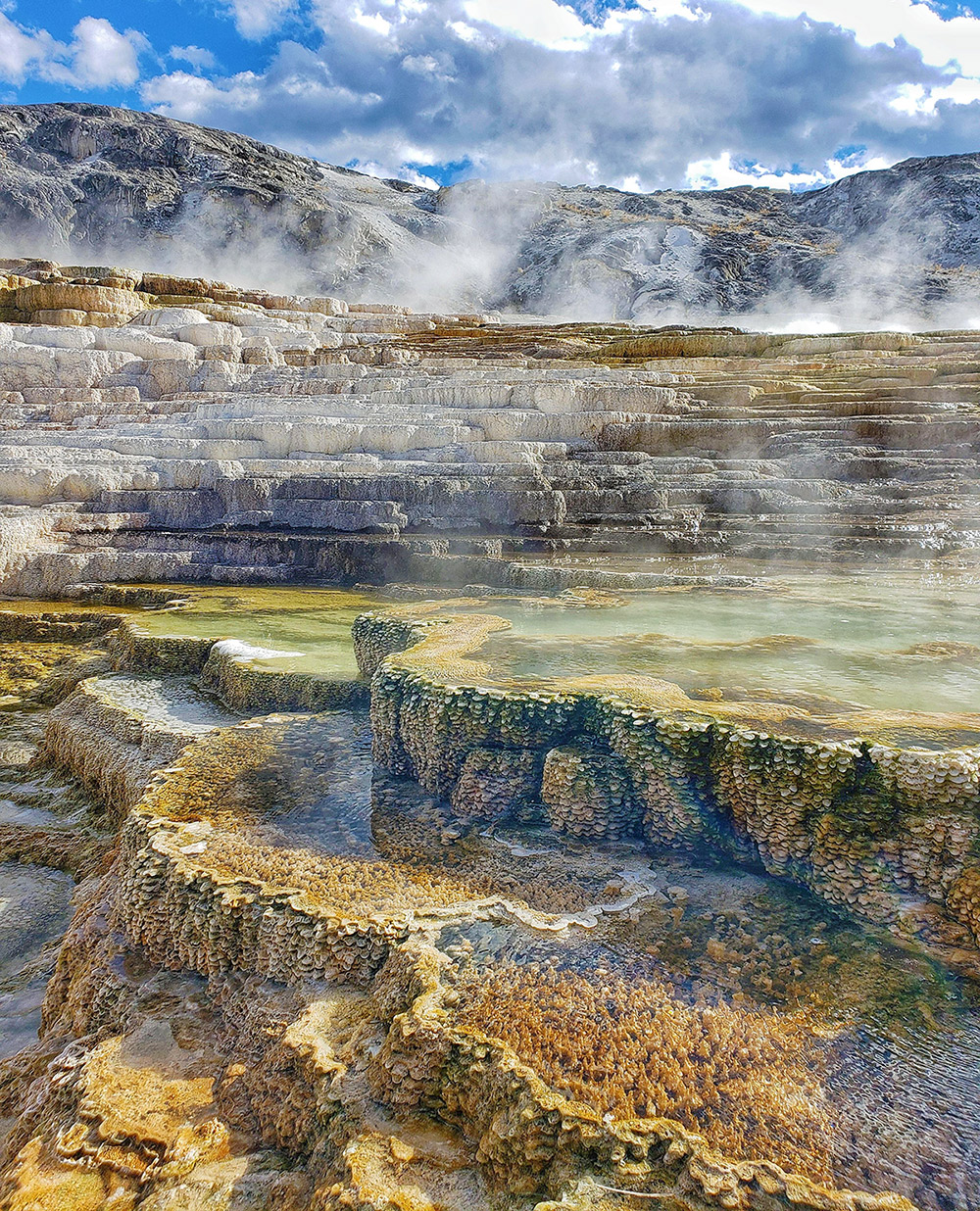
Yellowstone National Park’s Mammoth Hot Springs is a very unusual place to visit. As you approach, it seems to be a typical American suburban neighborhood. It’s like you’ve stepped back in time to a bit of village.
The Mammoth region is a short distance from the park’s northern gate. To put it another way, they’re a bit of a drive away from the likes of Old Faithful and the Lake Hotel, but they’re worth the effort.
The terraces at Mammoth Hot Springs are stunning, and the town of Mammoth is one-of-a-kind. In addition, the city of Gardiner, situated just outside the Yellowstone Park entrance, has many activities to keep visitors entertained.
The Mammoth Terraces are one of Yellowstone’s main geyser basins and one of the park’s most visually appealing thermal zones. White, pink, and dark red are just a few available hues, and the terrace’s various levels are flat.
It’s a joy for the entire family to explore these travertine formations that have been there for thousands of years. Getting to the upper terrace is a short walk from the parking lot on the roadside. You can take a boardwalk route to the lower and higher decks from the parking lot, where you can walk with a stroller if necessary. There are 1.75 miles of boardwalk overall.
For those who don’t have time to walk to the top travertine terraces boardwalk, don’t be deceived into believing this is a short stroll or a quick trek. Instead, carry a water bottle with you and wear layers.
The Mammoth hotel has a dining room, bar, Terrace Grill, petrol station, and primary shop. If you’re considering staying the night, make your reservations in advance.
Reserving a room for the next year may be done starting in May of the current year. So don’t wait until the last minute to book! The hotel’s dining area and lounge seemed to be high standard.
9. Morning Glory
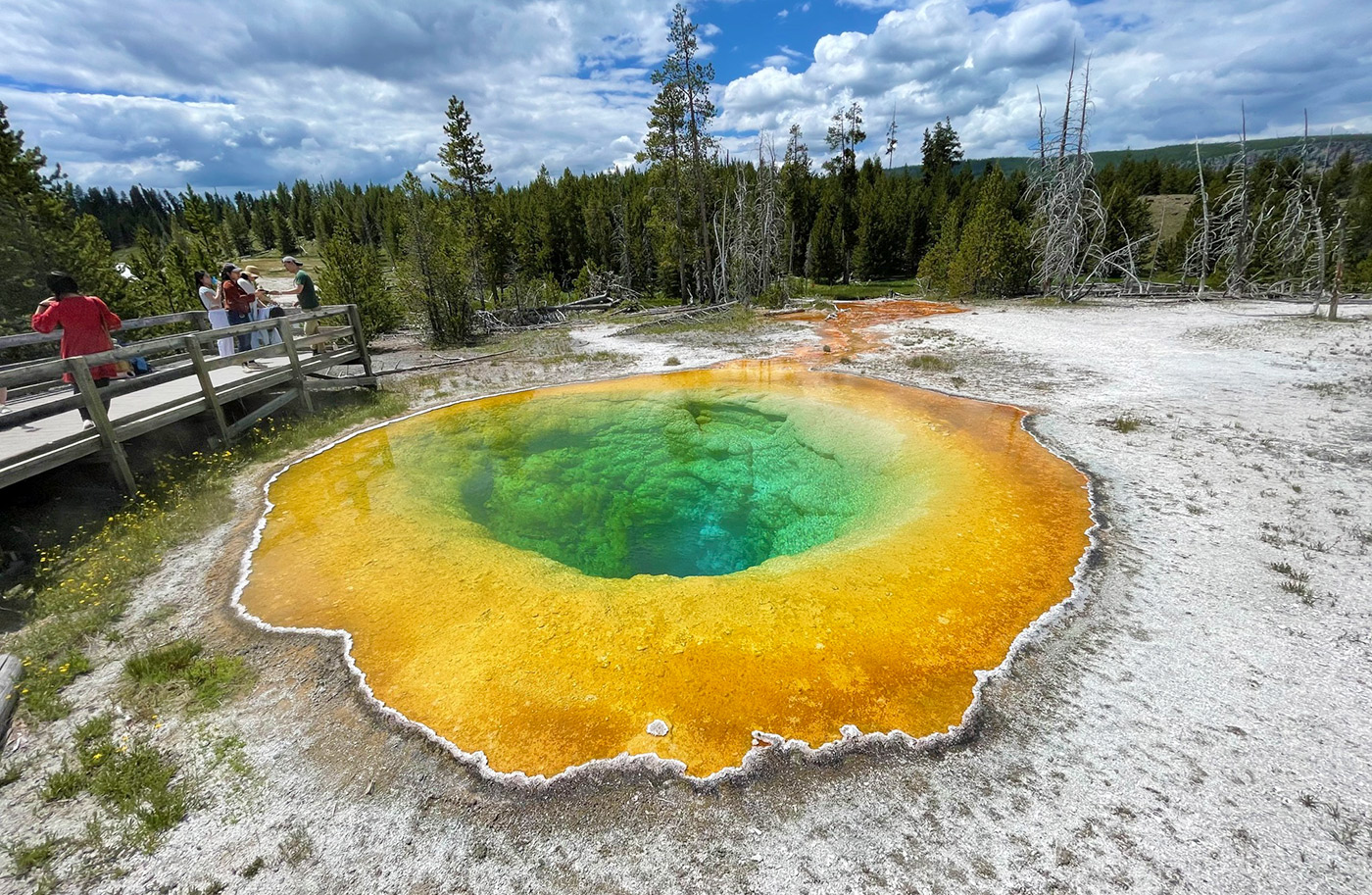
Morning Glory Pool is one of Yellowstone’s most famous hot springs, situated around a mile from Old Faithful. To get here, follow the paved walking/biking route to the end, where a boardwalk leads directly to it.
Its trumpet-shaped bloom is the inspiration for the name of this spring. The hue of the character also matched the color of the flower. On the other hand, this story highlights the sensitive nature of thermal characteristics.
Morning Glory Pool had a scalloped border that was 6-10 inches broad and 2-5 inches high in the park’s early days. Because everybody wanted to take a bit of it home, it was shortly gone. Now, luckily, this is not permitted. However, the delicate edging hasn’t rebuilt itself as expected by those who first arrived.
Visitors to the Upper Geyser Basin and Ancient Faithful can now use a newly constructed walking and bicycling trail that formerly served as the old road.
No matter where you look at it, the water in the very center is always blue. The color of the water is affected by its depth and the color of the water’s surface.
This used to be a beautiful, delicate fully blue pool, but today it’s yellow, orange, red, and green, with a hint of blue. Bacteria in the water caused the pool’s water to take on an incredible array of hues. The accumulation of different microorganisms forced the appearance of red and yellow circles.
While visiting, you can marvel at the beauty of nature’s richness, but remember to be mindful of the environment. The geyser sometimes erupts owing to seismic activity in the immediate vicinity. If this happens, scientists believe the pool cleanses itself.
It is more challenging to get to the pool; therefore, we suggest going from March to the end of November.
8. Chromatic Spring
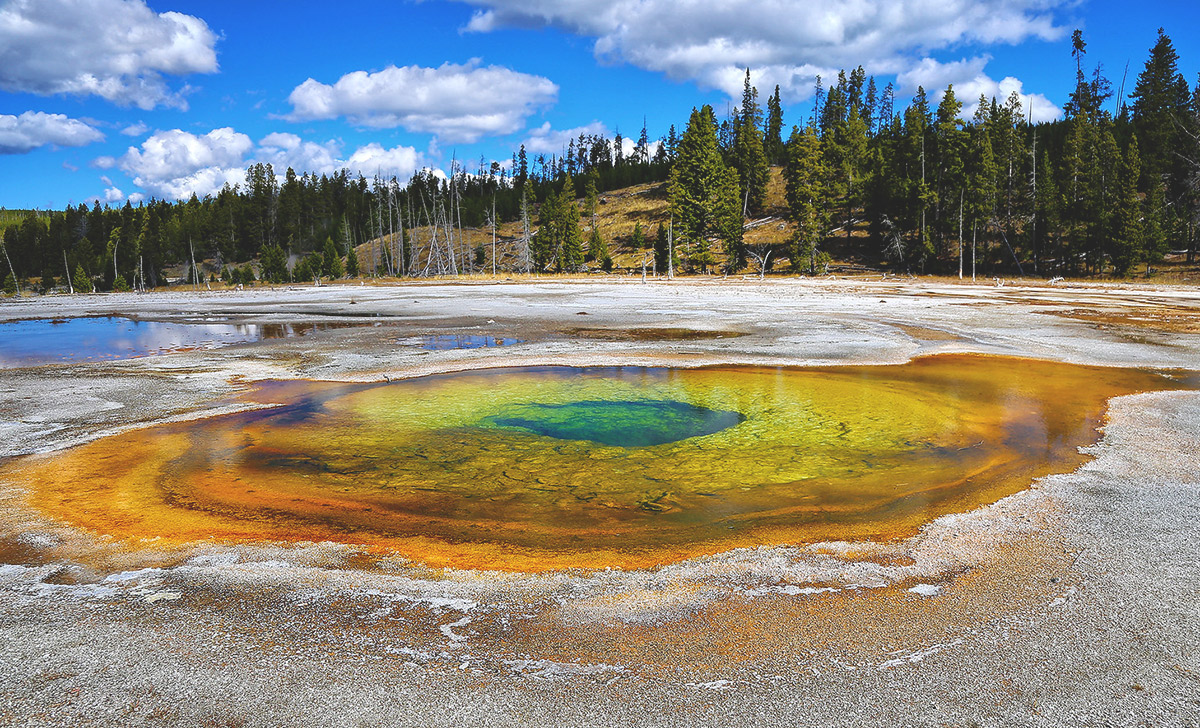
Chromatic Spring is a popular tourist destination located in Yellowstone’s Upper Geyser Basin. It is closely connected to the adjoining Beauty Pool, which displays its most striking colors when hotter water. Energy changes occur when one spring is higher and the other lower.
Located about 150 feet away from the similarly vibrant but more oversized Beauty Pool, Chromatic Spring is a small but striking oasis. Both are located next to the route, making them ideal for up-close exploration.
Even though it’s considerably smaller, the spring’s green-blue pool is roughly 30 feet across; much of it is shallow, with vibrant red and orange cyanobacteria coloring it, and the deep hues indicate that it’s not very warm.
The run-off channel travels north before turning west and joining the Firehole River. Although the spring’s water level rises and falls over a lengthy period (weeks to months), it does not explode.
It has an average temperature of 133.1°F, a pH of 8.5, and conductivity of 2096 uS/cm on average.
Within a short distance of Chromatic Spring, the trail reaches the Giant Group, Oblong Geyser’s first thermal feature.
7. Crested Pool
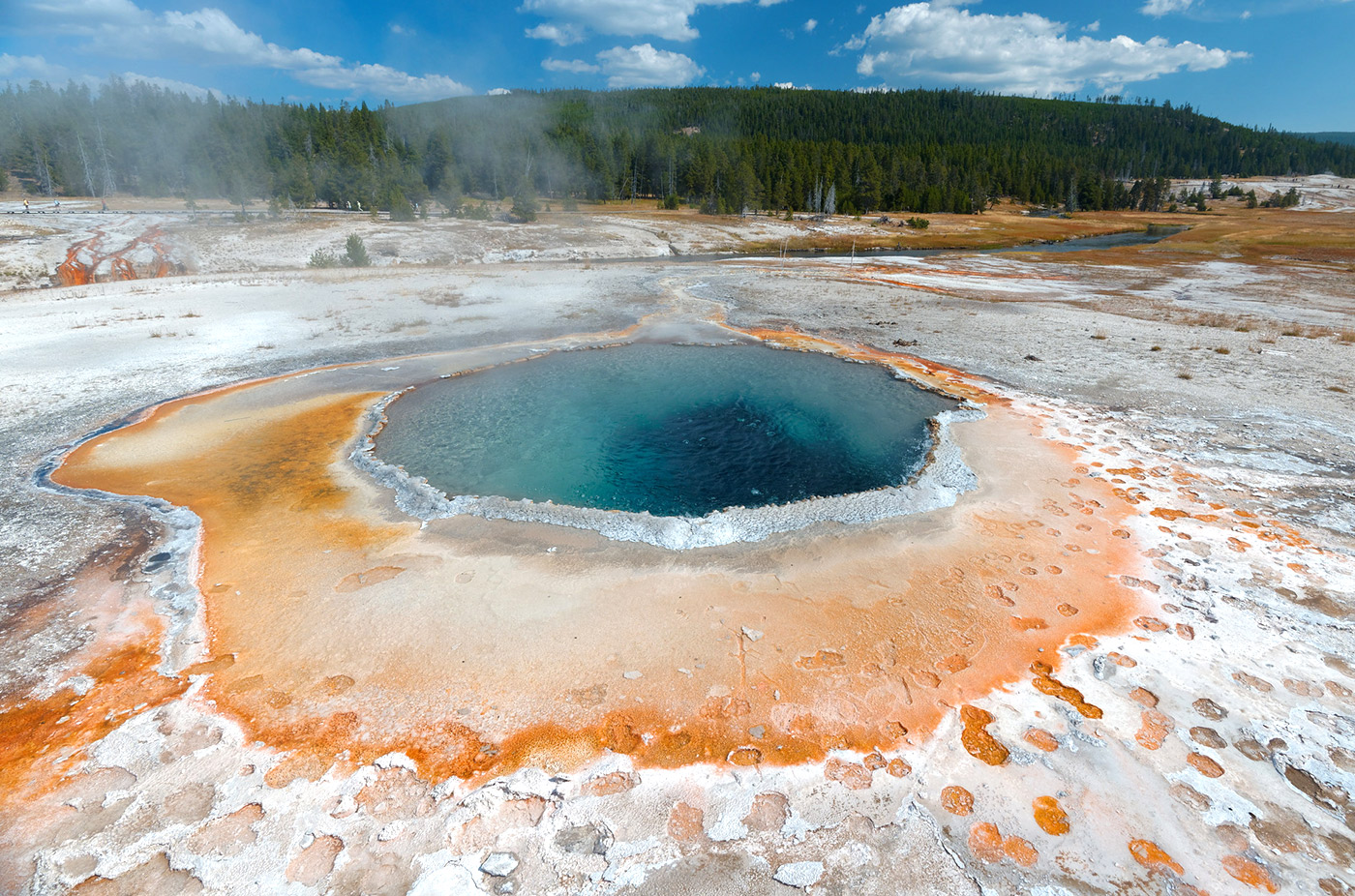
The Crested Pool is a 42-foot deep hot spring in Yellowstone National Park’s Upper Geyser Basin. The “crest” that encircles the pool inspired the pool’s name. It is a spring, but it can explode like a geyser from time to time.
Use the paved walking/biking route from Old Faithful to Castle Geyser to reach here. At Castle, do a U-turn and go along the boardwalk to the bridge.
This 10-sided pool killed someone. In this area, a little kid died terribly. In the end, it was never clear whether he purposefully leaped into a hot pool or accidentally fell in through the steam. Consequently, you’ll see installed warning signs and barriers.
Swimming in a Yellowstone pool filled with superheated water means that the water is hotter than its boiling point, which is approximately 199° F. As you would expect, the surface of these pools tends to remain calm with occasional crackling around the edges.
The boiling in Crested Pool can climb up to six feet during “bubble shower” eruptions. However, they aren’t the typical exploding eruptions that geysers are known for. They appear out of nowhere and last barely a few seconds.
This beautiful pool serves as a chilling reminder of the perils that lurk in Yellowstone and the need for everyone to take personal responsibility for their safety. To ensure your safety and the safety of the geyser basins’ thermal characteristics, visitors must adhere to the posted signs and remain on the boardwalks.
6. Doublet Pool
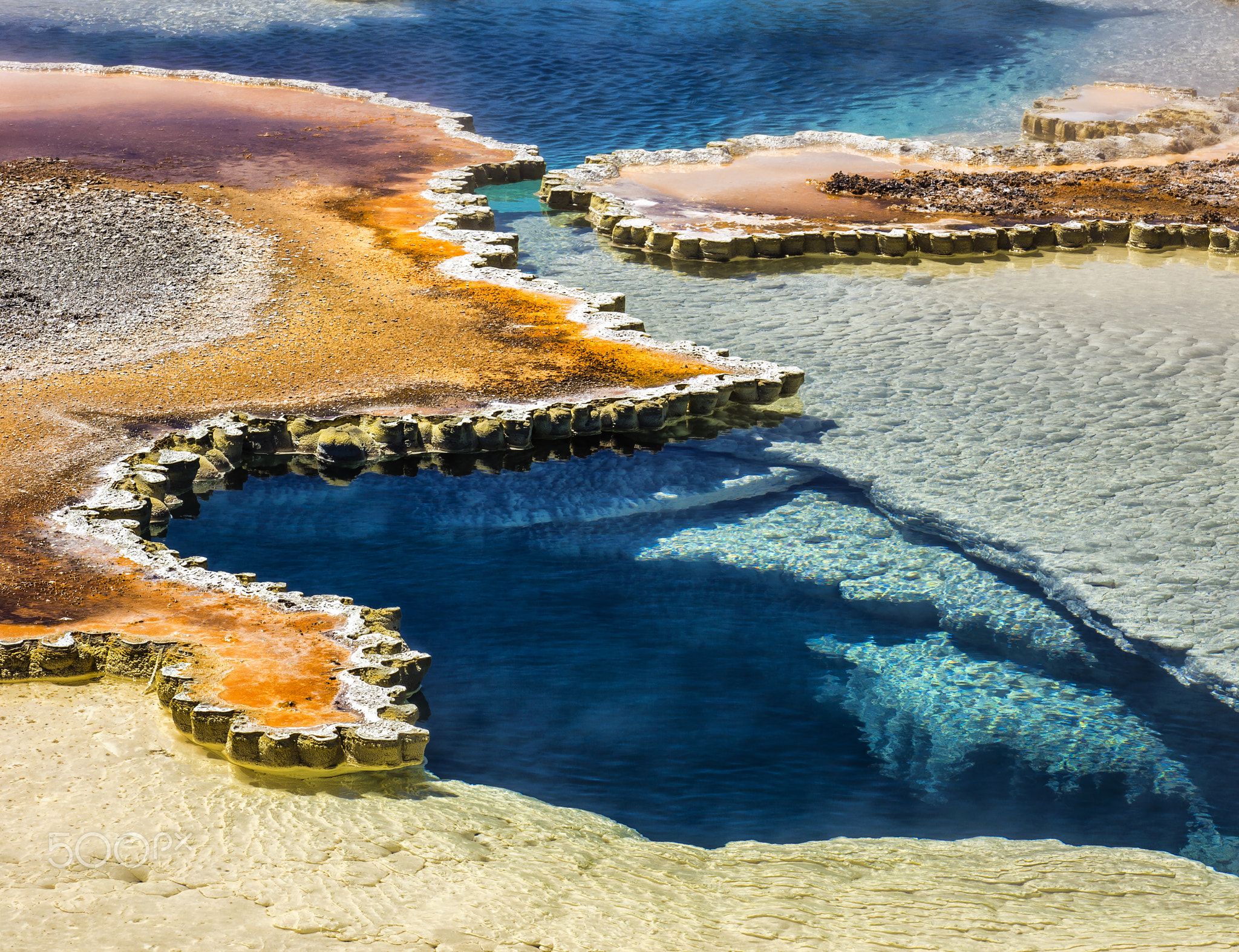
The Doublet Pool in the Upper Geyser Basin is one of the most beautiful hot springs in Yellowstone. For photographers, the lacy, scalloped border, and deep blue water make the short trip around the Geyser Hill circle well worth.
Two feet below the surface, a ledge leads to another. For many years, the water in these ledges (found at Blue Star Spring, Heart Spring, and elsewhere in the park) slowly overflowed at the same level.
The thickness of the ledges might indicate how much the sea level varied. The ledge at Doublet Pool is between two and three inches thick, showing that water flows regularly from the top to the bottom of the shelf. It tells you whether you’re nearing the point when you can feel, see, and hear thumps.
Doublet Pool’s water level climbs to the scalloped edge around once every 30 minutes or so. Bubbles and waves will begin to appear on the surface of the water as soon as the pool reaches its maximum capacity.
Once the thumps commence, the water rises up and out of the pool. Even if there are no people on the boardwalk or chatting too loudly, you can feel and hear the thumps during these uplift periods. The thumps are more audible if you sit down on a seat or place your palm on the boardwalk. For around five minutes, you’ll hear these sounds. It’s a seriously incredible experience!
5. Abyss Pool
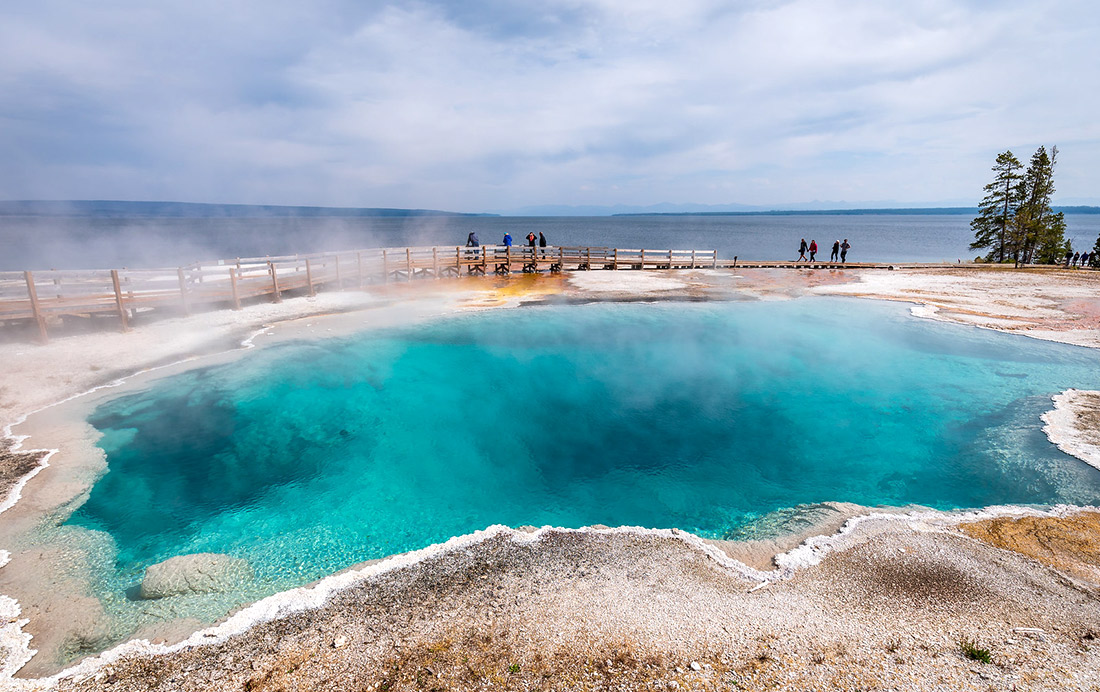
Even though it gets less attention than Old Faithful or other popular hot springs in Yellowstone, Yellowstone’s Abyss Pool is a stunning natural wonder.
Visitors to the park in 1883 characterized this body of water as “a big, clean, glittering sapphire vibrating with heat.”
Located in the West Thumb Geyser Basin, Abyss Pool offers visitors a relaxing hot spring experience. It’s 53 feet deep and filled with crystal-clear water.
Algae, minerals, and the water’s depth combine to give it its characteristic color. The hue of the water varies depending on the light and season, but it’s always beautiful.
Abyss Pool has initially been a geyser, although you’d never guess it from looking at it today. It erupted many times a day between December 1991 and June 1992, releasing 30-80-foot-high boiling water plumes.
The Abyss Pool is no longer erupting as of right now. Swimming is still out of the question in these waters, which are still between 100 and 200℉.
This unusual location’s vibrant hues and unearthly splendor make it well worth the trip.
You’ll need a wide-angle sports camera and a long selfie stick to get an excellent panoramic shot in the pool since the water is so large!
4. Lion Geyser
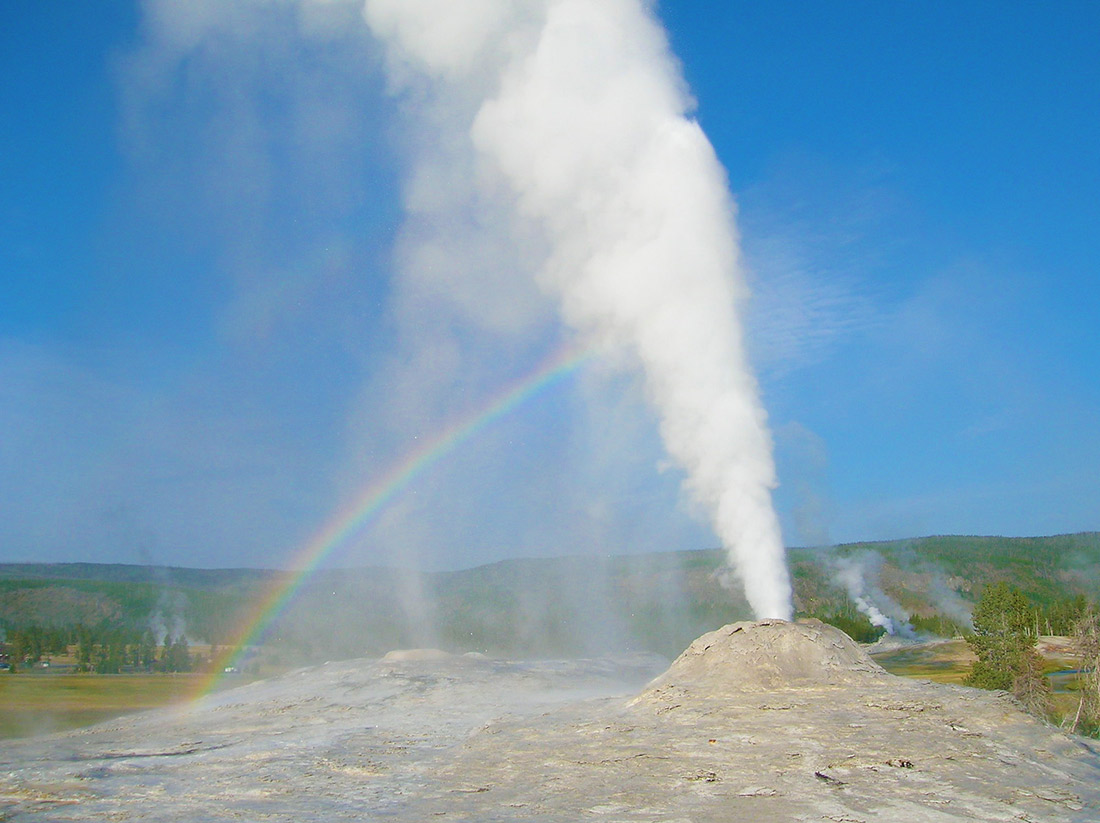
Yellowstone’s Upper Geyser Basin is home to the cone-shaped Lion Geyser. Its name comes from the roaring sound when steam is expelled during an eruption. From 1 to 7 minutes, the blasts can reach a height of 90 feet. Little Cub Geyser, Big Cub Geyser, and Lioness Geysers are no longer active, are all part of the Lion Group, which contains Lion.
Walk around Old Faithful until you reach the trail leading down to the Firehole River, and from there, you can access Lion Geyser. Take the path to the lower part of the Geyser Hill Loop from the boardwalk, linking it to the loop (a right). Take the lower boardwalk around to the other side of Geyser Hill when you arrive at Geyser Hill. You can reach Geyser Hill by following the passage from Castle Geyser or the Grand area.
The Lion Geyser works on a succession system, with everal eruptions over several hours until the system recharges. An eruption series can have one to nine eruptions, although most of the time, three to five eruptions occur before a halt is taken.
The “Drinking Fountain” (an unofficial term) will bubble as the system recharges before the initial explosion. It tells you that there is adequate water in the system, but it doesn’t mean you when the first eruption. You can find this small bubbler in the bacteria mat on the platform by returning the water to its source.
The first eruption in the sequence is higher and lasts a little longer than the others (including the steam phase). Consequently, the second eruption occurs around an hour and a half later. The vent would “roar” with a surge of rushing air before the successive explosions. The volcano explodes within a few minutes. When a series ends, Lion roars, but there is no further explosion.
3. Emerald Spring
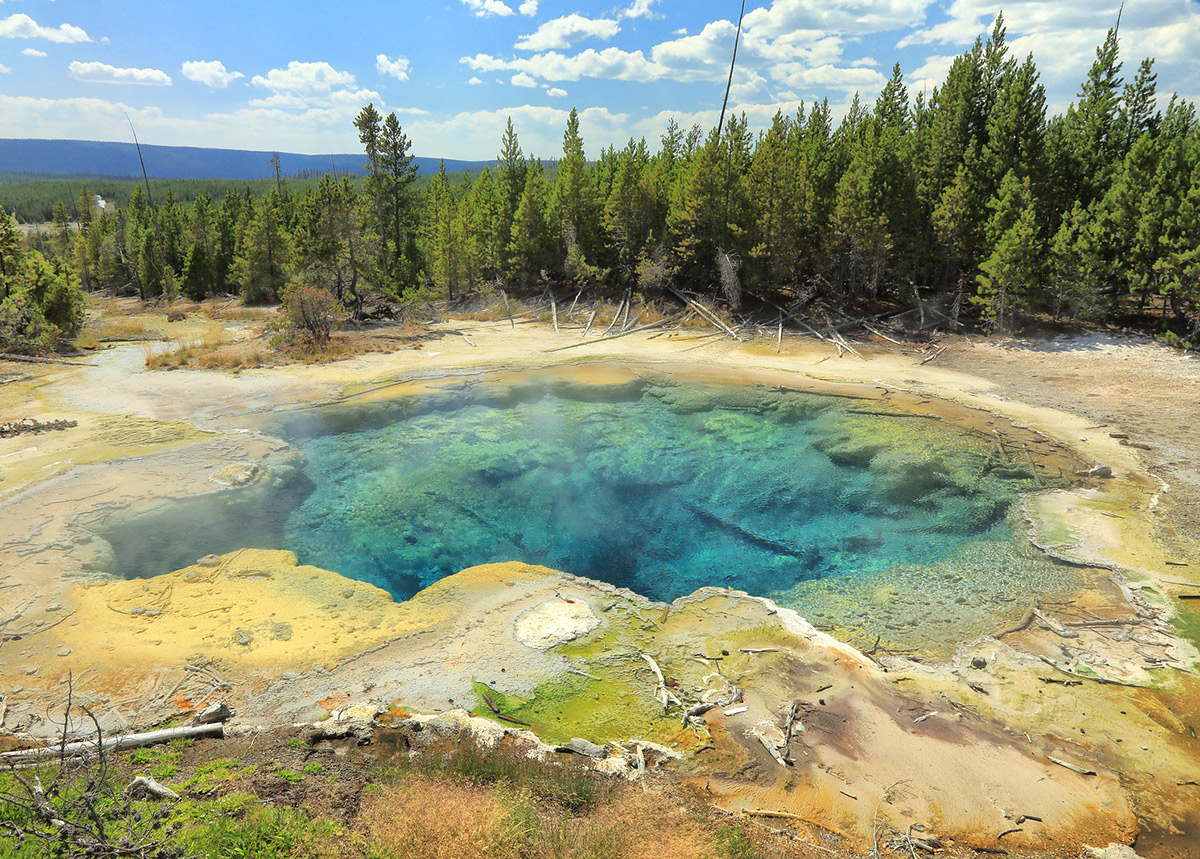
Emerald Spring is famous for visiting the Norris Geyser Basin in Yellowstone National Park.
Because of the sulfur-coated pool, Emerald Spring has a blue hue offset by yellow. If you’re not a thermophile, you won’t be able to make it out of this 27-foot deep pool alive.
Some bacteria in sulfur-rich hot springs, like Emerald Spring, utilize sulfur as an energy source. These processes produce byproducts that other bacteria can use. When microorganisms are “recycled” in this way, there’s a formation of different communities of organisms.
Conference facilities, a convenience shop (with 12 flavors of homemade ice cream), wireless Internet, special needs facilities, and road train parking are all available at Emerald Springs.
Pets are welcome at the Caravan Park, designated a “pet-friendly area” with a separate “off the leash” run area. It’s an excellent place for dogs to run, swim in the dam, and romp on the grass. As an added convenience, pet owners have access to a hydro-bath at the facility. The Convenience shop will have a variety of pet food.
Emerald Spring is a refuge for animals and birds because of the spring-fed streams that surround it. You can spot various birds, from Jabirus to Finches, in the area.
If you’re staying at the Grove Hill Heritage Hotel, a day excursion to Emerald Springs is a beautiful way to explore the region for crystals and gold.
2. Grand Prismatic Spring
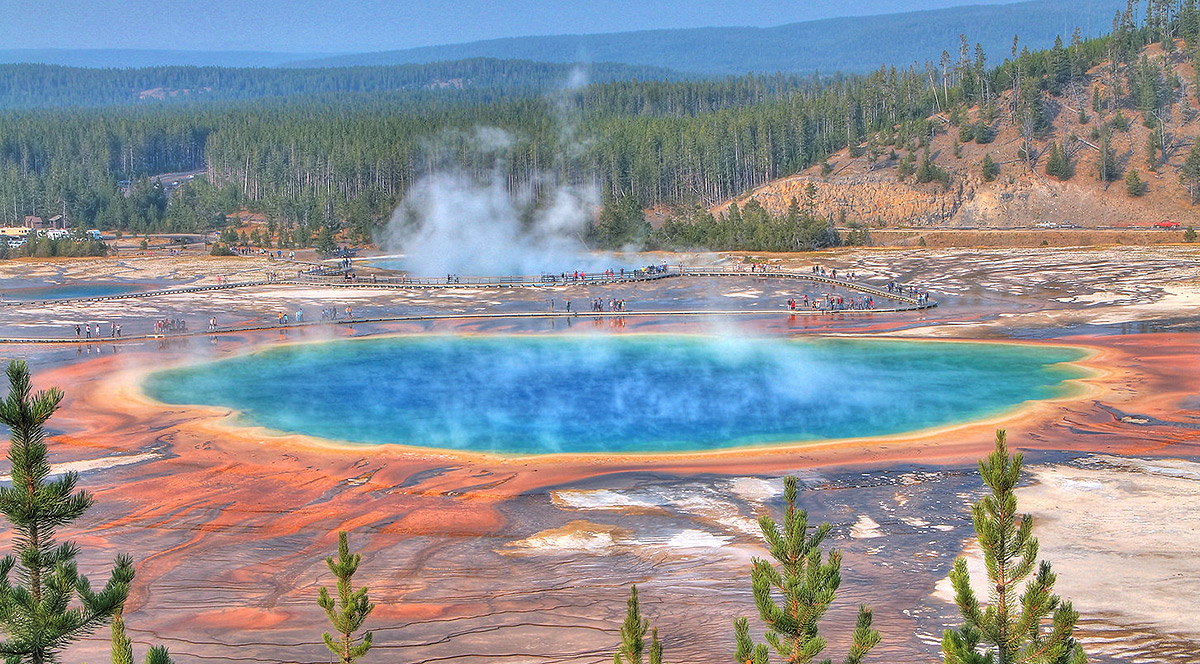
The Midway Geyser Basin’s Grand Prismatic Spring, or “the eye,” is one of Yellowstone National Park’s most outstanding attractions. It’s easy to see why this natural marvel is so popular, attracting millions of visitors each year.
It isn’t called “great” by accident, after all. It is the world’s third-largest hot spring, with a spectacular display of many colors. At 121 feet deep, it’s larger than a football field in circumference.
Tourists swarm to the Grand Prismatic Spring to showcase the spring’s vibrant colors and a “shower” of thick steam.
Grand Prismatic Spring has its unique hue. Colors include blue, green, yellow, orange, gold, red, and brown, reminiscent of a rainbow dispersed by an optical prism.
Several thermophile (heat-loving bacteria) species contribute to the springtime color pallet. The Grand Prismatic Spring is surrounded by many clumps of bacteria, known as bacterial mats, that develop in the cooler water.
It has a minimal amount of activities to choose from while you’re here. Walking off the boardwalk to gain a closer look at hydrothermal features is strictly prohibited. In the Midway Geyser Basin, Yellowstone’s fauna is likewise sparse.
Despite this, the Grand Prismatic Spring is at the top of most visitors’ lists while exploring Yellowstone National Park. The best reward is just seeing the natural splendor in person. Fortunately, you can view the Grand Prismatic Spring from close and far.
Once you’ve had your fill of the Grand Prismatic Spring, you can finally see it from above. To reach Grand Prismatic Overlook, you’ll have to make your way up the hill. Now, there is a new scenic spot in the area.
1. Boiling River
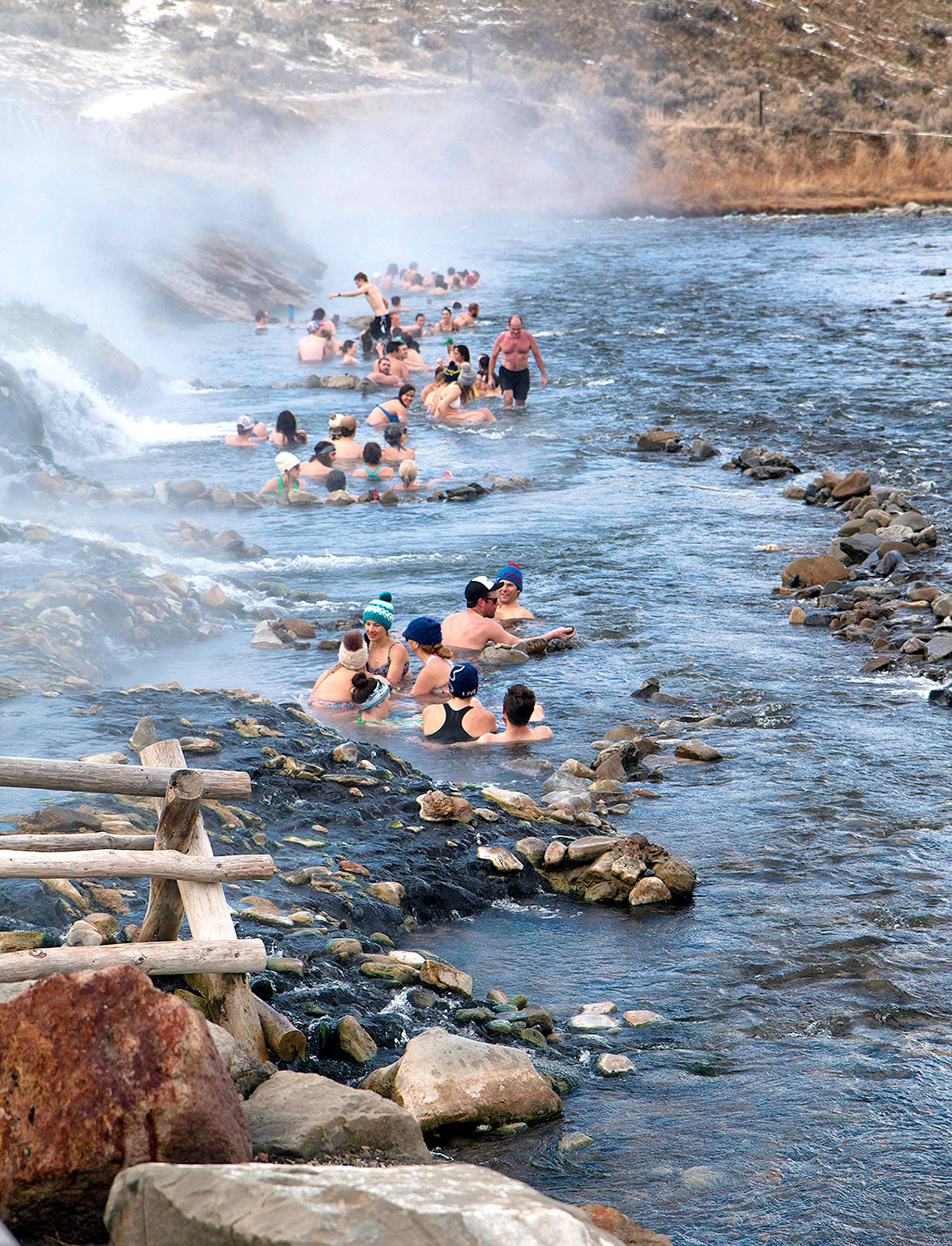
Take advantage of a true American landmark: the Boiling River, right in the heart of Yellowstone National Park! This area is much sought after by visitors. According to the seasonal bathing preferences of many tourists, the particular point at which naturally heated waters flow into cooler temps provides a different, refreshing experience.
Yellowstone’s Boiling River is a state-sanctioned “spa,” so there’s no reason why you can’t take a dip in it. Boiling River is a seasonal attraction in northern Yellowstone accessible from the summer to winter. It is between Mammoth Hot Springs and the park’s official north entrance.
At the end of a short, readily navigable trail, you’ll likely find a group of people already enjoying the distinctive qualities of Yellowstone’s Boiling River hot spring. The route is about 1.25 miles round-trip, making it an easy adventure to well worth the effort.
It’s important to note that the streams leading up to the Boiling River are unsuitable for swimming and can reach 113° to 140° F.
As a result of the organisms present in Yellowstone’s hot spring, visitors may experience rashes, infections, or other skin irritations. However, there is no better place to begin your Yellowstone hot springs and pools adventure than Boiling River!
Yellowstone Hot Springs Safety Tips
There are over 10,000 hydrothermal phenomena in Yellowstone National Park, but these hot springs are some of the most stunning.
- Except for the Boiling River, none of these hot springs are safe for swimming.
- When visiting the springs, be sure to stay on the boardwalk or approved route at all times. The soil around these hot springs is brittle and might lead to dangerously hot water under the surface.
- Keep your hands out of the water. When it’s this hot, individuals have died by falling into the hazardous springs.
- Do not toss anything into the springs. It harms the water quality and eventually alters the spring’s appearance.
- Do not go to the hot springs at night.
- The hot springs can be dangerous for tiny children, so use extra care near them. We highly suggest that parents use a stroller to prevent their children from escaping. There are several boardwalks without railings.
These are the greatest bubbling and boiling springs in Yellowstone National Park! If you’ve ever visited one of these calming havens, please share your thoughts with us.
